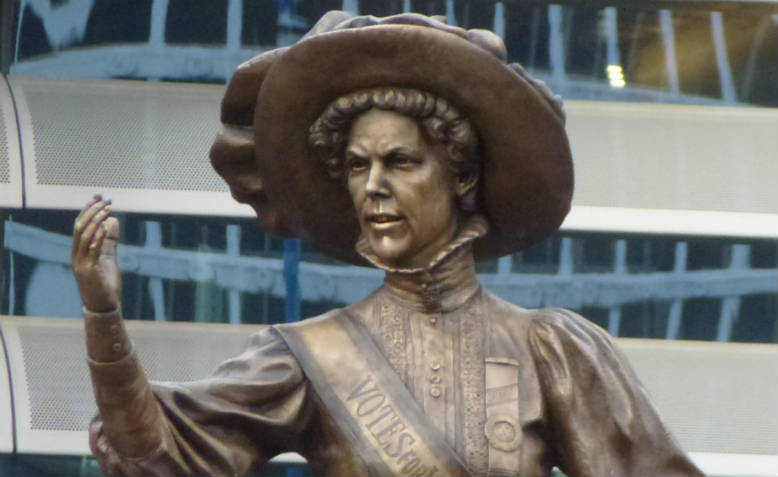 Photo: Wikimedia Commons
Photo: Wikimedia Commons
Marking a hundred years of some women winning the right to vote, a statue of Suffragette Alice Hawkins was erected in Leicester. Jacqueline Mulhallen reports
Lynx Theatre and Poetry was in Leicester on 3 February to perform Sylvia, Jacqueline Mulhallen’s acclaimed play about Sylvia Pankhurst.
Sylvia had visited Leicester in 1907 to paint the women working in the Equity co-operative shoe factory. She had been invited there by Alice Hawkins, a left-wing member of the WSPU and trade unionist, and Lynx had been invited to perform as part of the celebrations around the unveiling of a statue to Alice, and to join the unveiling and official reception.
There are plenty of statues in England erected to men – generals, MPs, aristocrats – and a few erected to women. According to the Guardian, of 925 public statues in Britain, only 158 are of solo women. Women frequently represent allegorical or mythical themes such as Justice, and most of the statues of real people are of royal figures, including 29 of Queen Victoria! Of women as activists, only Emmeline Pankhurst, founder of the Women’s Social and Political Union, seems to have been celebrated, although a statue to Millicent Garrett Fawcett, who was the leader of the National Union of Women’s Suffrage Societies, is planned. Both these organisations included many working-class members who were the campaigners who won the vote for women 100 years ago. Even then, women did not gain the right to vote on equal terms with men until 1928 – women under 30 were excluded in 1918.
For a statue to be erected to one of these working-class women, the shoemaker, trade unionist and suffragette Alice Hawkins, in the centre of Leicester, is a triumph and an accolade to the tireless campaigning of Peter Barratt, Alice’s great grandson. Peter wanted the statue to be a memorial not just to his great grandmother, Alice, but to all working women who fought for the right to vote, for equal pay and better conditions 100 years ago. He got enthusiastic support from Leicester Council and funding from a local businessman, Jamie Lewis, who now owns the former Equity shoe factory where Alice worked.
On Sunday people singing suffragette songs braved the hail and formed a colourful march through Leicester to arrive at the Market Place. There hundreds more people had been standing or sitting listening to speeches as they waited for the march to arrive. Among the speakers were Sean Hedges-Quinn, who told us that this was only the second woman he had been commissioned to sculpt, and described the process of designing it; City Mayor Sir Peter Soulsby; MP for Leicester West Liz Kendal; Jamie Lewis and Peter Barratt. The audience had also been well entertained by the wonderful De Montfort University Gospel Choir.
At 3 p.m. (in cold but brighter weather) the bronze statue was unveiled – and it is an excellent portrait of an inspiring woman! More pictures from the Leicester Mercury.
So at last there is a statue to a working-class woman activist and not to a queen or a mythical figure. This is a first for Leicester, and probably for England. For once, this is a statue to a working class person, erected to commemorate working class activity, working class courage and working class solidarity – with the support of the people of Leicester.

